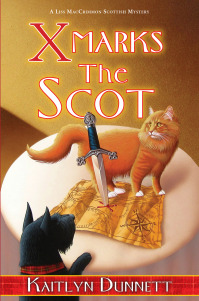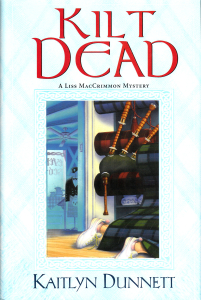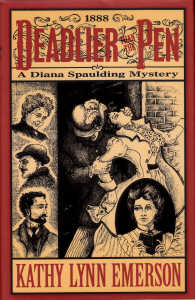 Kaitlyn Dunnett/Kathy Lynn Emerson here, author of the recently published X Marks the Scot, number eleven in the Liss MacCrimmon series. The first Liss MacCrimmon mystery, Kilt Dead, came out in August 2007. Once a series has been around for over ten years, and is still being published (my current contract covers #12 and #13), it can probably be considered long-running, but only if you don’t compare it to, say, J.D. Robb’s “In Death” series, which numbers forty-six to date and has more in the pipeline. Still, considering the number of mystery series that never get past the first two or three books, Liss’s adventures aren’t doing too badly.
Kaitlyn Dunnett/Kathy Lynn Emerson here, author of the recently published X Marks the Scot, number eleven in the Liss MacCrimmon series. The first Liss MacCrimmon mystery, Kilt Dead, came out in August 2007. Once a series has been around for over ten years, and is still being published (my current contract covers #12 and #13), it can probably be considered long-running, but only if you don’t compare it to, say, J.D. Robb’s “In Death” series, which numbers forty-six to date and has more in the pipeline. Still, considering the number of mystery series that never get past the first two or three books, Liss’s adventures aren’t doing too badly.
 And that, gentle readers, brings me to the topic of this blog. Having books in a series published at regular intervals by a traditional, advance-and-royalty-paying publisher is what passes for job security in the writing biz. I am extremely lucky (and grateful) to be in that situation. Along the way, I’ve learned a thing or two, observations I thought I’d share here at Maine Crime Writers.
And that, gentle readers, brings me to the topic of this blog. Having books in a series published at regular intervals by a traditional, advance-and-royalty-paying publisher is what passes for job security in the writing biz. I am extremely lucky (and grateful) to be in that situation. Along the way, I’ve learned a thing or two, observations I thought I’d share here at Maine Crime Writers.
 With the second Liss MacCrimmon mystery, Scone Cold Dead, I confirmed something I’d begun to suspect when I was writing my previous long-running series, the historical Face Down Mysteries. That series, featuring sixteenth-century herbalist Susanna Appleton, consists of ten novels and a collection of short stories and then some of those characters reappeared in my three-book spin-off series, the Mistress Jaffrey Mysteries. In each series, and in my Diana Spaulding 1888 Quartet, which was intended to be a limited series of four books, book two was a real challenge to whip into shape.
With the second Liss MacCrimmon mystery, Scone Cold Dead, I confirmed something I’d begun to suspect when I was writing my previous long-running series, the historical Face Down Mysteries. That series, featuring sixteenth-century herbalist Susanna Appleton, consists of ten novels and a collection of short stories and then some of those characters reappeared in my three-book spin-off series, the Mistress Jaffrey Mysteries. In each series, and in my Diana Spaulding 1888 Quartet, which was intended to be a limited series of four books, book two was a real challenge to whip into shape.
 I have a feeling the second book in any series almost always is. Writers usually have to put a great deal of time and effort into writing the first one, and into pitching the series idea to agents and publishers. I’m talking years here, unless Lady Luck puts in a fortuitous appearance. Then lightning strikes, a multi-book contract is signed, and suddenly there’s a deadline to “do the same thing again, only different.” You’d think that would be easy. It isn’t. The time limit alone works against creativity, and this time around the writer isn’t just sitting alone in the proverbial attic (or coffee house). There’s input from an editor, and possibly from an agent. And if the first book is already out, there are readers offering their opinions about things like the protagonist’s likeability. Both well-intentioned feedback and negative reviews can be hard to handle. Both can produce feelings of insecurity and self-doubt, and make the writer second-guess every decision about plot or character development.
I have a feeling the second book in any series almost always is. Writers usually have to put a great deal of time and effort into writing the first one, and into pitching the series idea to agents and publishers. I’m talking years here, unless Lady Luck puts in a fortuitous appearance. Then lightning strikes, a multi-book contract is signed, and suddenly there’s a deadline to “do the same thing again, only different.” You’d think that would be easy. It isn’t. The time limit alone works against creativity, and this time around the writer isn’t just sitting alone in the proverbial attic (or coffee house). There’s input from an editor, and possibly from an agent. And if the first book is already out, there are readers offering their opinions about things like the protagonist’s likeability. Both well-intentioned feedback and negative reviews can be hard to handle. Both can produce feelings of insecurity and self-doubt, and make the writer second-guess every decision about plot or character development.
Writing the third book in a series is definitely easier. Not easy, you understand, but much less of a slog.
 With book four in the Liss MacCrimmon series, The Corpse Wore Tartan, I ran into a different of problem. Even though I’d made character sheets, and maps of my fictional town of Moosetookalook, Maine, and had floor plans of Liss’s house, Dan’s house, and the hotel where many scenes take place, I’d neglected to make note of some of the details I’d put in books one through three. I had to go back and reread my own books to remember what I’d already set up . . . because readers who discover a series new to them tend to read straight through the books that are available. Believe me when I say that no contradiction goes unnoticed! I’m better at keeping track these days, but there are still things I should write down and don’t. Finding them again later is a royal pain.
With book four in the Liss MacCrimmon series, The Corpse Wore Tartan, I ran into a different of problem. Even though I’d made character sheets, and maps of my fictional town of Moosetookalook, Maine, and had floor plans of Liss’s house, Dan’s house, and the hotel where many scenes take place, I’d neglected to make note of some of the details I’d put in books one through three. I had to go back and reread my own books to remember what I’d already set up . . . because readers who discover a series new to them tend to read straight through the books that are available. Believe me when I say that no contradiction goes unnoticed! I’m better at keeping track these days, but there are still things I should write down and don’t. Finding them again later is a royal pain.
 A chronology is a good idea too. I have one for Liss’s world that includes birth dates for all the continuing characters, when they graduated from high school and college, how long they held certain jobs in the past, and when they first appeared in Moosetookalook, among other details in their lives. It’s surprising how often knowing how old a character is in relation to the other characters turns out to be significant.
A chronology is a good idea too. I have one for Liss’s world that includes birth dates for all the continuing characters, when they graduated from high school and college, how long they held certain jobs in the past, and when they first appeared in Moosetookalook, among other details in their lives. It’s surprising how often knowing how old a character is in relation to the other characters turns out to be significant.
I’ve learned the hard way, too, that I need to keep the calendar in mind when I write each new book. I never say what year it is, but I know, and I use a calendar for that year to make sure I keep the days straight. Holidays can really mess things up. What if you need to check public records and the town office is closed? And you can’t really ignore the big ones like Thanksgiving, Christmas, and the 4th of July. Then, too, if I’m writing about Maine in the winter, I’d better know the times of sunrise and sunset for my location.
 Of course some of these observations apply to writing any book, not necessarily one in a long-running series. One situation, however, usually takes awhile to surface. For me, it was at book ten, Kilt at the Highland Games. Here’s a sad truth: after you’ve written a bunch of books about the same characters in the same setting, you start to worry about running out of fresh ideas. I was afraid of repeating myself. The “same only different” isn’t the same as the “same-old same-old.” I started Liss’s tenth adventure with a fire in downtown Moosetookalook. The devil on my shoulder was urging me to burn down the whole damn town. Fortunately, I didn’t listen, but I did give serious consideration to ending the series at book ten.
Of course some of these observations apply to writing any book, not necessarily one in a long-running series. One situation, however, usually takes awhile to surface. For me, it was at book ten, Kilt at the Highland Games. Here’s a sad truth: after you’ve written a bunch of books about the same characters in the same setting, you start to worry about running out of fresh ideas. I was afraid of repeating myself. The “same only different” isn’t the same as the “same-old same-old.” I started Liss’s tenth adventure with a fire in downtown Moosetookalook. The devil on my shoulder was urging me to burn down the whole damn town. Fortunately, I didn’t listen, but I did give serious consideration to ending the series at book ten.
 With that thought in mind, I spent considerable time working on a proposal for a new series, one with a sleuth closer to my own age. I wrote it in first person instead of the third person point of view I used for the Liss MacCrimmon books. I set it not in Maine, but in a fictional village in rural New York state a lot like the one I grew up in. By the time it was far enough along for my agent to pitch to the editor I’d been working with at Kensington, I’d had a real break from Liss and her friends, and when that editor indicated that he was interested in the new series but would also like to see more Liss MacCrimmons, I realized (with some surprise) that I actually had a fresh idea for a new one, an idea that eventually turned into X Marks the Scot.
With that thought in mind, I spent considerable time working on a proposal for a new series, one with a sleuth closer to my own age. I wrote it in first person instead of the third person point of view I used for the Liss MacCrimmon books. I set it not in Maine, but in a fictional village in rural New York state a lot like the one I grew up in. By the time it was far enough along for my agent to pitch to the editor I’d been working with at Kensington, I’d had a real break from Liss and her friends, and when that editor indicated that he was interested in the new series but would also like to see more Liss MacCrimmons, I realized (with some surprise) that I actually had a fresh idea for a new one, an idea that eventually turned into X Marks the Scot.
My biggest piece of advice for any writer who fears a long-running series may be running out of steam is really pretty simple. Take a break. Write something different. Let your subconscious worry about breathing new life into the characters and events in book eleven, or twelve, or even forty-seven.

Kathy Lynn Emerson/Kaitlyn Dunnett is the author of more than fifty-five traditionally published books written under several names. She won the Agatha Award and was an Anthony and Macavity finalist for best mystery nonfiction of 2008 for How to Write Killer Historical Mysteries and was an Agatha Award finalist in 2015 in the best mystery short story category. She was the Malice Domestic Guest of Honor in 2014. Currently she writes the contemporary Liss MacCrimmon Mysteries and the “Deadly Edits” series (Crime & Punctuation—2018) as Kaitlyn and the historical Mistress Jaffrey Mysteries (Murder in a Cornish Alehouse) as Kathy. The latter series is a spin-off from her earlier “Face Down” mysteries and is set in Elizabethan England. Her most recent collection of short stories is Different Times, Different Crimes. Her websites are www.KaitlynDunnett.com and www.KathyLynnEmerson.com and she maintains a website about women who lived in England between 1485 and 1603 at A Who’s Who of Tudor Women.
Share this:





